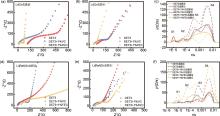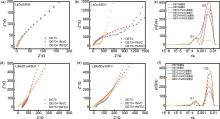Energy Storage Science and Technology ›› 2025, Vol. 14 ›› Issue (9): 3249-3258.doi: 10.19799/j.cnki.2095-4239.2025.0217
• Energy Storage Materials and Devices • Previous Articles Next Articles
Yan ZHAO1,2( ), Hao LIU1,2, Zonglin YI1, Li LI1,2, Lijing XIE1, Fangyuan SU1(
), Hao LIU1,2, Zonglin YI1, Li LI1,2, Lijing XIE1, Fangyuan SU1( )
)
Received:2025-03-06
Revised:2025-03-22
Online:2025-09-28
Published:2025-09-05
Contact:
Fangyuan SU
E-mail:zhaoyan22@mails.ucas.ac.cn;sufangyuan@sxicc.ac.cn
CLC Number:
Yan ZHAO, Hao LIU, Zonglin YI, Li LI, Lijing XIE, Fangyuan SU. Interfacial behavior of FEC and VC at graphite anode of lithium-ion batteries[J]. Energy Storage Science and Technology, 2025, 14(9): 3249-3258.

Fig. 3
Nyquist plots of cells before and after SEI formation in different electrolytes (a) Li|Gr battery before SEI formation; (b) Li|Gr battery after SEI formation; (d) Li|Ref|Gr battery before SEI formation; (e) Li|Ref|Gr battery after SEI formation; DRT plot (c) DRT resolution before and after SEI formation in Li|Gr battery; (f) DRT resolution before and after SEI formation in Li|Ref|Gr battery"


Fig. 4
Nyquist plot (a) Li|Cu battery before SEI formation; (b) Li|Cu battery after SEI formation; (d) Li|Ref|Cu battery before SEI formation; (e) Li|Ref|Cu battery after SEI formation; DRT plot (c) DRT resolution before and after SEI formation in Li|Cu battery; (f) DRT resolution before and after SEI formation in Li|Ref|Cu battery"

| [1] | DIOUF B, PODE R. Potential of lithium-ion batteries in renewable energy[J]. Renewable Energy, 2015, 76: 375-380. DOI: 10.1016/j.renene.2014.11.058. |
| [2] | 张贵萍, 闫筱炎, 王兵, 等. 长寿命循环的磷酸铁锂电池及材料、工艺[J]. 储能科学与技术, 2023, 12(7): 2134-2140. DOI: 10.19799/j.cnki.2095-4239.2023.0381. |
| ZHANG G P, YAN X Y, WANG B, et al. Long life lithium iron phosphate battery and its materials and process[J]. Energy Storage Science and Technology, 2023, 12(7): 2134-2140. DOI: 10.19799/j.cnki.2095-4239.2023.0381. | |
| [3] | PELED E, MENKIN S. Review—SEI: Past, present and future[J]. Journal of the Electrochemical Society, 2017, 164(7): A1703-A1719. DOI: 10.1149/2.1441707jes. |
| [4] | XU K. Manipulating interphases in batteries open access[J]. National Science Review, 2017, 4(1): 19-20. DOI: 10.1093/nsr/nww043. |
| [5] | ZHAO Q, STALIN S, ARCHER L A. Stabilizing metal battery anodes through the design of solid electrolyte interphases[J]. Joule, 2021, 5(5): 1119-1142. DOI: 10.1016/j.joule.2021.03.024. |
| [6] | ZHANG S S. A review on electrolyte additives for lithium-ion batteries[J]. Journal of Power Sources, 2006, 162(2): 1379-1394. DOI: 10.1016/j.jpowsour.2006.07.074. |
| [7] | JIN Y T, KNEUSELS N H, MARBELLA L E, et al. Understanding fluoroethylene carbonate and vinylene carbonate based electrolytes for Si anodes in lithium ion batteries with NMR spectroscopy[J]. Journal of the American Chemical Society, 2018, 140(31): 9854-9867. DOI: 10.1021/jacs.8b03408. |
| [8] | LI Y C, CAO Z, WANG Y, et al. New insight into the role of fluoro-ethylene carbonate in suppressing Li-trapping for Si anodes in lithium-ion batteries[J]. ACS Energy Letters, 2023, 8(10): 4193-4203. DOI: 10.1021/acsenergylett.3c01328. |
| [9] | TEUFL T, PRITZL D J, HARTMANN L, et al. Implications of the thermal stability of FEC-based electrolytes for Li-ion batteries[J]. Journal of the Electrochemical Society, 2023: DOI: 10.1149/1945-7111/acbc52 |
| [10] | ZHOU X, LI P, TANG Z H, et al. FEC additive for improved SEI film and electrochemical performance of the lithium primary battery[J]. Energies, 2021, 14(22): 7467. DOI: 10.3390/en14227467. |
| [11] | YAMAZAKI S, TATARA R, MIZUTA H, et al. Consumption of fluoroethylene carbonate electrolyte-additive at the Si-graphite negative electrode in Li and Li-ion cells[J]. The Journal of Physical Chemistry C, 2023, 127(29): 14030-14040. DOI: 10. 1021/acs.jpcc.3c00843. |
| [12] | 邓邦为, 孙大明, 万琦, 等. 锂离子电池三元正极材料电解液添加剂的研究进展[J]. 化学学报, 2018, 76(4): 30-48. DOI: 10.6023/A17110517. |
| DENG B W, SUN D M, WAN Q, et al. Review of electrolyte additives for ternary cathode lithium-ion battery[J]. Acta Chimica Sinica, 2018, 76(4): 30-48. DOI: 10.6023/A17110517. | |
| [13] | GRUGEON S, JANKOWSKI P, CAILLEU D, et al. Towards a better understanding of vinylene carbonate derived SEI-layers by synthesis of reduction compounds[J]. Journal of Power Sources, 2019, 427: 77-84. DOI: 10.1016/j.jpowsour.2019.04.061. |
| [14] | BURNS J C, PETIBON R, NELSON K J, et al. Studies of the effect of varying vinylene carbonate (VC) content in lithium ion cells on cycling performance and cell impedance[J]. Journal of the Electrochemical Society, 2013, 160(10): A1668-A1674. DOI: 10.1149/2.031310jes. |
| [15] | TALAIE E, BONNICK P, SUN X Q, et al. Methods and protocols for electrochemical energy storage materials research[J]. Chemistry of Materials, 2017, 29(1): 90-105. DOI: 10.1021/acs.chemmater.6b02726. |
| [16] | XIAO Y, XU R, YAN C, et al. A toolbox of reference electrodes for lithium batteries[J]. Advanced Functional Materials, 2022, 32(13): 2108449. DOI: 10.1002/adfm.202108449. |
| [17] | 肖也, 徐磊, 闫崇, 等. 锂电池用参比电极的设计与应用[J]. 储能科学与技术, 2024, 13(1): 82-91. DOI: 10.19799/j.cnki.2095-4239. 2023.0638. |
| XIAO Y, XU L, YAN C, et al. Design and application of reference electrodes for lithium batteries[J]. Energy Storage Science and Technology, 2024, 13(1): 82-91. DOI: 10.19799/j.cnki.2095-4239.2023.0638. | |
| [18] | 周思飞, 李骏, 王小飞, 等. 锂电池电解液电导率模型研究进展[J]. 储能科学与技术, 2022, 11(11): 3688-3698. DOI: 10.19799/j.cnki.2095-4239.2022.0344. |
| ZHOU S F, LI J, WANG X F, et al. Research progress in the conductivity model of lithium battery electrolytes[J]. Energy Storage Science and Technology, 2022, 11(11): 3688-3698. DOI: 10.19799/j.cnki.2095-4239.2022.0344. | |
| [19] | PELJO P, GIRAULT H H. Electrochemical potential window of battery electrolytes: The HOMO-LUMO misconception[J]. Energy & Environmental Science, 2018, 11(9): 2306-2309. DOI: 10.1039/C8EE01286E. |
| [20] | XU K. Electrolytes, interfaces and interphases[M]. London: The Royal Society of Chemistry, 2023. |
| [21] | ZHOU X, HUANG J, PAN Z Q, et al. Impedance characterization of lithium-ion batteries aging under high-temperature cycling: Importance of electrolyte-phase diffusion[J]. Journal of Power Sources, 2019, 426: 216-222. DOI: 10.1016/j.jpowsour.2019.04.040. |
| [22] | KUO J J, KANG S D, CHUEH W C. Contact resistance of carbon-Lix(Ni, Mn, Co)O2 interfaces[J]. Advanced Energy Materials, 2022, 12(31): 2201114. DOI: 10.1002/aenm.202201114. |
| [1] | Xiuwen TAN, Ling LI. Study on the thermal runaway characteristics of lithium-ion batteries and their thermal management under local overheating conditions [J]. Energy Storage Science and Technology, 2025, 14(9): 3521-3529. |
| [2] | Wenyan CHEN, Ruilin HE, Jian CHANG, Yonghong DENG. Investigation of lithium storage mechanisms in liquid metal electrodes with different morphologies [J]. Energy Storage Science and Technology, 2025, 14(9): 3290-3300. |
| [3] | Jijin LIN, Qian LIU, Tao QU, Jingkun LI, Dongyong HUANG, Xiaoqing ZHU, Xing JU. Technical and economic analysis of liquid immersion cooling for lithium-ion battery energy storage system [J]. Energy Storage Science and Technology, 2025, 14(9): 3622-3635. |
| [4] | Juqiang FENG, Chengzhi ZHANG, Yuhang CHEN. A high-precision SOC and temperature joint estimation method based on rapid prototype modeling [J]. Energy Storage Science and Technology, 2025, 14(9): 3567-3580. |
| [5] | Xiaoyu BAI, Yajing YAN, Zhirong ZHANG, Lingli KONG. Research on the performance of composite graphite lithium-ion batteries [J]. Energy Storage Science and Technology, 2025, 14(9): 3259-3268. |
| [6] | Lei ZHANG. Operating status monitoring and evaluation of lithium-ion battery energy storage power stations [J]. Energy Storage Science and Technology, 2025, 14(9): 3538-3540. |
| [7] | Xinyu BAO, Xiangdong KONG, Taolin LV, Zhicheng ZHU, Xuebing HAN, Xin LAI, Yuejiu ZHENG, Tao SUN. Battery internal resistance prediction and rapid sorting method based on production line big data [J]. Energy Storage Science and Technology, 2025, 14(9): 3541-3551. |
| [8] | Chengshan XU, Ye SUN, Zhikai YANG, Mingqiang ZHAO, Yalun LI, Xuning FENG, Hewu WANG, Languang LU, Minggao OUYANG. Research progress on arc induced by thermal runaway in lithium-ion battery systems for energy storage [J]. Energy Storage Science and Technology, 2025, 14(8): 3037-3050. |
| [9] | Pengju LI, Xiaoyu CHEN, Jia XIE, Jiani SHEN, Yijun HE. Research progress on state of power prediction methods for lithium-ion batteries [J]. Energy Storage Science and Technology, 2025, 14(8): 3028-3036. |
| [10] | Liyue HU, Wei HUANG, Yun ZHOU, Yingqiang ZHOU, Changzheng SHAO, Ke WANG. Fuzzy reasoning-based evaluation of the thermal diffusion probability of lithium-ion battery modules for energy storage systems [J]. Energy Storage Science and Technology, 2025, 14(7): 2662-2674. |
| [11] | Feng XIONG, Depeng KONG, Ping PING, Yue ZHANG, Xiantong REN, Yao LV. Study on the characteristics of electrothermal coupling-induced thermal runaway of ternary lithium-ion batteries [J]. Energy Storage Science and Technology, 2025, 14(7): 2752-2760. |
| [12] | Wenyuan WENG, Bin SHEN, Jiangong ZHU, Yang WANG, Huapeng LU, Wuliyasu HE, Haonan LIU, Haifeng DAI, Xuezhe WEI. Detecting hazardous lithium plating on anodes of lithium-ion batteries—A review of in situ methods [J]. Energy Storage Science and Technology, 2025, 14(7): 2575-2589. |
| [13] | Zijing ZHANG, Beibei YUAN, Hong LI, Ying GAO. Thermal runaway gas detection and early warning of lithium-ion batteries [J]. Energy Storage Science and Technology, 2025, 14(7): 2820-2832. |
| [14] | Jiahui LIU, Weixiang BIAN, Dawei LI. In situ measurement and analysis of the electromechanical coupling performance of composite graphite electrodes in lithium batteries [J]. Energy Storage Science and Technology, 2025, 14(6): 2240-2247. |
| [15] | Chunling WU, Liding WANG, Yong LU, Limin GENG, Hao CHEN, Jinhao MENG. Lithium-ion batteries SOH estimation based on gaussian processed regression optimized by egret swarm optimization [J]. Energy Storage Science and Technology, 2025, 14(6): 2498-2511. |
| Viewed | ||||||
|
Full text |
|
|||||
|
Abstract |
|
|||||
